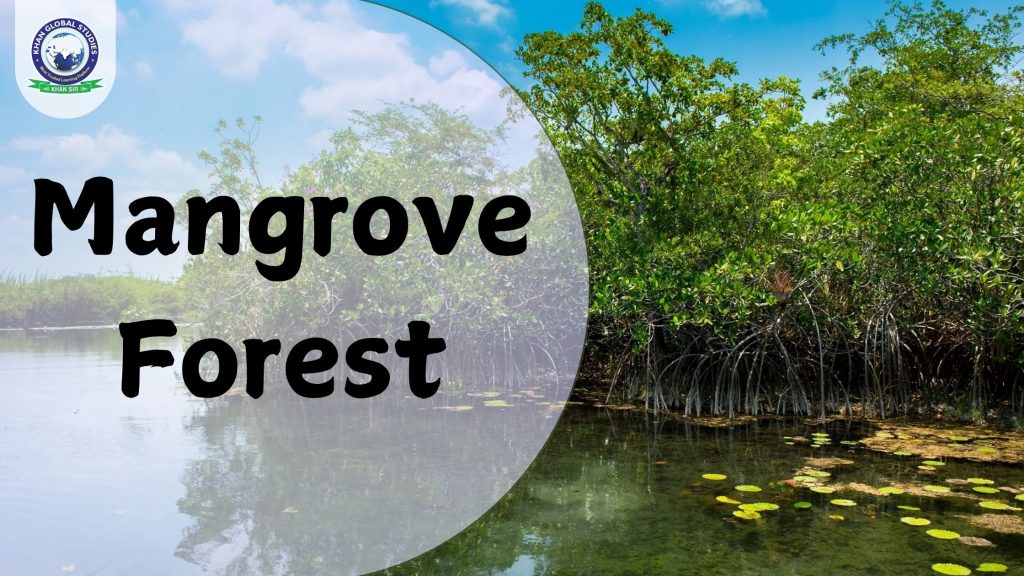Mangrove forests are unique ecosystems found in coastal areas, particularly in areas with saltwater and river deltas. These forests consist of salt-tolerant trees and shrubs that thrive in intertidal zones’ muddy, sandy, peaty soils. Mangrove forests are important from an ecological perspective because they protect coastal areas from erosion and help preserve biodiversity.
What Are Mangrove Forests?
Mangroves refer to plants and trees that are specially adapted to survive in salty and brackish water. These plants grow in waterlogged or swampy areas, with a distinctive root system designed to stabilize soil and protect the land from sea waves. Their roots, some of which protrude above the soil, are a natural defence against coastal erosion.
Mangroves vary in size, from small shrubs to giant trees up to 60 meters, found mainly in Ecuador and parts of the Americas. Globally, there are about 12 mangrove species, and these ecosystems are mainly located in tropical and subtropical regions.
History of Mangrove Forests
Mangrove forests have an ancient history, having evolved millions of years ago, mainly in tropical and subtropical regions. Historically, these forests have played an important role in maintaining the biodiversity of coastal areas. Before human intervention, mangroves were widely spread across the Earth’s coastlines. However, due to urbanization and other human activities, their numbers have decreased significantly.
In the 18th century, European botanists began the systematic study of mangrove ecosystems. Over time, their importance was recognized globally, and today, the focus is on preserving these important ecosystems.
Where do Mangroves Grow?
Mangroves thrive in a variety of soils, including mud, sand, peat, and coral reefs. They are known for their ability to withstand saltwater and tidal flooding, conditions that kill most tree species. Mangroves can be found in a variety of environments, from the open ocean to inland rivers, depending on their adaptation to soil moisture and salt levels.
Mangrove Forests in India
India has a rich diversity of mangrove forests. Notable mangrove areas include the Sundarbans in West Bengal, the Mahanadi Delta in Odisha, the Godavari-Krishna Delta in Andhra Pradesh, and the Andaman and Nicobar Islands. The Sundarbans, which stretches across both India and Bangladesh, is the largest mangrove forest in the world. Mangroves in India cover an area of about 4,975 square kilometres.
Mangrove Root Systems and Reproduction
1. Unique Root Systems: Mangrove trees have special root systems that grow above the ground, called aerial roots. These roots come in various forms, such as:
- Stilt Roots: These grow out of the trunk and lower branches, forming loops.
- Plank Roots: These are wide, wavy roots that extend far from the tree trunk.
These aerial roots provide stability to the mangrove by anchoring it to soft, loose soil, much like the flying buttresses of a cathedral. These roots also allow the tree to “breathe” by absorbing oxygen through lenticels, tiny pores in the bark, and roots that close to prevent flooding during high tide.
2. Seed Germination
Mangroves have developed unique reproductive strategies to thrive in their coastal environment. Their seeds begin to germinate while still attached to the parent tree, ensuring they are ready to take root when fall arrives.
During high tide, the seeds float until they find solid ground. At low tide, they quickly establish themselves in soft soil. Some mangrove species develop long, spear-shaped propagules that can remain attached to the parent tree for up to three years, ready to either take root nearby or drift to distant shores.
3. Global Distribution of Mangroves
Mangroves are believed to have originated in Southeast Asia and spread globally via ocean currents. Their seeds, fruits, and saplings can float for more than a year before taking root. Mangrove ecosystems have since spread to about 120 countries, covering an area of about 152,000 square kilometres. The largest mangrove forests can be found in India, Bangladesh, Indonesia, Thailand, Malaysia, Brazil, and Mexico.
Why are Mangroves Important?
Mangroves play a vital role in coastal protection, acting as a natural barrier against storms, cyclones, and erosion. Additionally, they provide habitat for many marine species and contribute significantly to maintaining coastal ecosystems.
Ecological Importance of Mangroves
- Coastal Protection: Mangroves protect coastal areas from storms, tsunamis, and erosion.
- Carbon Sequestration: These forests are carbon sinks, helping to combat climate change by sequestering large amounts of carbon.
- Soil Stabilization: Their complex root systems prevent soil erosion and stabilize coastal lands.
- Livelihood Support: Mangroves are essential to the livelihoods of coastal communities, which support activities such as fishing, honey gathering and timber harvesting.
- Biodiversity Conservation: Mangrove forests support many species, serve as breeding grounds for fish and other aquatic life and provide shelter for many organisms.
How do Mangroves Survive?
- Salt Tolerance: Mangroves can filter up to 90% of the salt from seawater before it reaches their roots. Some species expel excess salt through their leaves, leaving salt crystals on the leaf surface. Others concentrate salt in older leaves or bark, which they eventually shed.
- Freshwater Storage: Like desert plants, some mangrove species store freshwater in their thick, succulent leaves. Others have waxy coatings to prevent water loss through evaporation. Some species also have tiny hairs on their leaves to reduce sun exposure and minimize water loss.
- Breathing in Flooded Areas: Mangroves have special pneumatophores, or breathing roots, that stick out of the ground like a snorkel. These roots help the mangroves absorb oxygen even during the regular flooding caused by the tides.
Biodiversity in the Mangrove Ecosystem
Mangroves are home to over 70 plant species and countless species of animals, including fish, crabs, snails, and birds. In the Sundarbans, the Royal Bengal Tiger is the most iconic resident. Mangroves are also home to mudskippers, fiddler crabs, and other creatures that are uniquely adapted to this dynamic environment.
Threats to Mangrove Forests
Over the past few decades, mangrove forests have faced a lot of destruction due to development activities, urbanization, agriculture, and tourism. Since the 20th century, the world has lost about 35% of its mangrove forests.
Consequences of Mangrove Depletion
- Increased Flood Risk: Without mangroves, coastal areas are more vulnerable to flooding and storm surges.
- Threats to Marine Life: Deforestation of mangroves destroys habitats for fish, crabs and other species, affecting marine biodiversity.
- Soil Erosion: The absence of mangroves leads to faster soil erosion, causing seawater to encroach on coastal land.
- Environmental Imbalance: Mangroves are vital in the fight against climate change. Their destruction contributes to environmental degradation.
Conclusion
Mangrove forests are vital for protecting coastal areas, preserving biodiversity and combating climate change. Urgent steps must be taken to preserve these ecosystems, including raising awareness among local communities and implementing conservation policies. Without prompt action, the consequences of mangrove loss could be devastating.
Frequently Asked Questions
Q: What are mangrove forests?
Ans: Mangrove forests are unique coastal forests that grow in saltwater and help prevent coastal erosion.
Q: Which is the largest mangrove forest in India?
Ans: The Sundarbans, located in India and Bangladesh, is the largest mangrove forest in the world.
Q: Why are mangrove forests important?
Ans: Mangrove forests are essential for coastal protection, biodiversity conservation, and carbon storage.
Q: What is the global area of mangrove forests?
Ans: Globally, mangrove forests cover about 152,000 square kilometres.
Q: What are the threats to mangrove forests?
Ans: Urbanization, agriculture, and coastal development are the major causes of mangrove forest destruction.




